|
|
|
Sort Order |
|
|
|
Items / Page
|
|
|
|
|
|
|
| Srl | Item |
| 1 |
ID:
096375


|
|
|
|
|
| Publication |
2010.
|
| Summary/Abstract |
From the establishment of the United States Postal Service and the invention of the telegram, to the introduction of C-SPAN and the explosion of the Internet, the development of new communication technologies has always affected the functioning of Congress. Not surprisingly, recent innovations such as e-mail and social networking have spurred Congress to alter the way it operates as an institution, and rethink the manner in which it engages the public. In this brief examination, I discuss recent changes in congressional behavior and practices due to technological innovation, specifically the proliferation of social networking Web sites. Then, I cautiously predict future trends in the use of social networking and related technologies as they become more integrated in congressional offices and increase the capacity for more robust internal and constituent communications over time.
|
|
|
|
|
|
|
|
|
|
|
|
|
|
|
|
| 2 |
ID:
163095


|
|
|
|
|
| Summary/Abstract |
With the world’s ninth largest economy and comprising nearly 60% of South America’s GDP, 47% of its territory, and 49% of its population, Brazil has become a regional power and an important actor in world affairs over recent decades. This scenario has led the government to re-evaluate its role in the world order, resulting in the enactment of the National Defence Policy, whose objective was to consolidate the country as a regional power while at the same time addressing national security issues, promoting economic development through a series of defence programmes, restructuring the defence industrial base, fostering innovation through technology and knowledge transfer to Brazil, and indigenous research and development. However, the policy’s implementation suffers from several challenges discussed in this article, which may test the capability and competence of Brazilian policymakers, military, industrialists, and other individuals and organisations involved in its implementation.
|
|
|
|
|
|
|
|
|
|
|
|
|
|
|
|
| 3 |
ID:
137673


|
|
|
|
|
| Summary/Abstract |
In 2013, China׳s national government abandoned its previous cautious policy and started to promote large-scale deployment of coal-based synthetic natural gas (SNG). Coal-based SNG is both carbon-intensive and very water-intensive. Driven by a smog crisis and the recession of coal industry, China׳s 2013 policy change is major setback in its long-term efforts in carbon mitigation and water conservation. The government of China made the policy change before the commercial commencement of China׳s first SNG demonstration plant. Since the commencement of China׳s SNG demonstration plant, many problems have started to appear. In this article, I discuss the nature of demonstration project and explain the danger in starting a crash program without evaluating the demonstration comprehensively and transparently.
|
|
|
|
|
|
|
|
|
|
|
|
|
|
|
|
| 4 |
ID:
074432
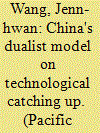

|
|
|
|
|
| Publication |
2006.
|
| Summary/Abstract |
The central question of this paper is whether China can go beyond simple technological transfer and toward innovation in this age of globalization. By adopting an institutionalist perspective, this paper argues that China has developed a dualist model during its economic transitional period in which the foreign sector has been isolated from domestic firms, while the domestic industrial sectors have also failed to develop organic linkages among themselves to facilitate technological learning and generate innovation. This paper discusses four major institutional arrangements that deeply influence China's technological development - the institutional logic of economic reform, the state's industrial policy, the financial system and the industrial structure. It suggests that, owing to these institutional elements, China has neither developed economies of scale, as compared with the South Korean case, nor has it built up a network-type of economy similar to its Taiwanese counterpart in order to generate the mechanisms needed for technological innovation.
|
|
|
|
|
|
|
|
|
|
|
|
|
|
|
|
| 5 |
ID:
086248
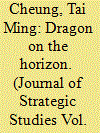

|
|
|
|
|
| Publication |
2009.
|
| Summary/Abstract |
China's grand ambition is to become a world-class military industrial power by 2020, but can it succeed? A concerted restructuring of the defense industry is taking place to tackle deep-seated obstacles constraining its ability to absorb, create and diffuse technological innovation. This includes promoting competition and creativity by reducing the reach of the state and encouraging enterprises to play a leading role, developing a robust regulatory and standards regime to provide benchmarks and rules, and forging integration between the civilian and military portions of the economy through spin-ons.
|
|
|
|
|
|
|
|
|
|
|
|
|
|
|
|
| 6 |
ID:
110375


|
|
|
|
|
| Publication |
2011.
|
| Summary/Abstract |
This paper studies patenting dynamics in efficiency improving electricity generation technologies as an important indicator of innovation activity. We build a novel database of worldwide patent applications in efficiency-improving fossil fuel technologies for electricity generation and then analyse patenting trends over time and across countries. We find that patenting has mostly been stable over time, with a recent decreasing trend. OECD countries represent the top innovators and the top markets for technology. Some non-OECD countries, and particularly China, are also very active in terms of patenting activity in this sector. The majority of patents are first filed in OECD countries and only then in BRIC and other non-OECD countries. BRIC and other non-OECD countries apply for patents that are mostly marketed domestically, but BRIC countries represent important markets for patent duplication of OECD inventions. These results are indicative of significant technology transfer in the field of efficiency-improving technologies for electricity production.
|
|
|
|
|
|
|
|
|
|
|
|
|
|
|
|
| 7 |
ID:
119916
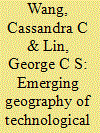

|
|
|
|
|
| Publication |
2013.
|
| Summary/Abstract |
This study critically evaluates the relevance of the existing theory of technological innovation to the case of China's information and communications technology industry. Based on a large-scale questionnaire survey conducted in China's three most important city-regions, namely, Beijing, Shanghai and Shenzhen, where the core of China's information and communications technology industry is located, this study reveals a significant regional variation in technological innovation in a political economy undergoing marketisation and globalisation. This research has found no significant relationship between the innovative performance of firms and the extent of production linkages; nor was there a significant knowledge exchange among firms. A further analysis has identified the significant role played by government purchases, research and development capital input and export propensity in the process of technological innovation. The findings of this research cast doubts over the prevailing theory of 'new economic geography' in which soft and unbounded relational assets have been overemphasised at the expense of some solid and bounded actors and agents that are pivotal to technological innovation in a developing economy.
|
|
|
|
|
|
|
|
|
|
|
|
|
|
|
|
| 8 |
ID:
181085


|
|
|
|
|
| Summary/Abstract |
In the vast literature on terrorism the choice of weapons has received relatively limited attention, despite the importance and visibility of this topic. Building on the literature on innovation in terrorism, the article first proposes a multi-level analytical framework that helps study terrorist weapon selection. It then investigates the use of weapons in jihadist attacks in Europe from 2014, with the rise of the so-called Islamic State, until 2020, based on an original database. The empirical analysis shows that the two traditional types of weapon of modern terrorism, firearms and explosives, were largely replaced by more primitive tools like melee weapons. In fact, in recent years jihadist terrorists in Europe have become less technologically advanced. Based on the original analytical framework, the article examines the reasons of this evolution, paying special attention to the use of the most common type of weapon in the database, bladed weapons, and the most lethal type, firearms.
|
|
|
|
|
|
|
|
|
|
|
|
|
|
|
|
| 9 |
ID:
002491


|
|
|
|
|
| Publication |
New York, Crane, Russak & Company, 1977.
|
| Description |
x, 70p.
|
| Series |
Strategy paper; 30
|
| Standard Number |
0844812579
|
|
|
|
|
|
|
|
|
|
|
|
Copies: C:1/I:0,R:0,Q:0
Circulation
| Accession# | Call# | Current Location | Status | Policy | Location |
| 033942 | 327.101/GRA 033942 | Main | On Shelf | General | |
|
|
|
|
| 10 |
ID:
138415


|
|
|
|
|
| Summary/Abstract |
Recent years have seen the emergence of an international market for higher education. It is likely that the number of international students worldwide may have reached 5.2 million in 2014, with these students responsible for expenditures for tuition, accommodation, and other living expenses of no less than $50 billion. Since 1970, the number of international students is estimated to have doubled every fifteen years, on average, and the pace may be accelerating because of the expanding pool of tertiary education graduates in emerging economies where more education suppliers are entering the market. Experts predict that there will be at least 8 million international students by market. 2025, a larger group than the total population of Switzerland, Norway, or Ireland. This article traces the growth of student migration to the Cold War period when it was driven largely by the competition between the Soviet bloc and the West for influence in the developing world, how it has since been transformed (and now is being driven mainly by competition for dominance in technological innovation and trade), and concludes with questions on what it means for the less-developed countries of origin.
|
|
|
|
|
|
|
|
|
|
|
|
|
|
|
|
| 11 |
ID:
083371
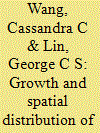

|
|
|
| 12 |
ID:
160481


|
|
|
|
|
| Summary/Abstract |
How does maintaining international primacy affect a hegemon's domestic political economy? Debates on hierarchy, retrenchment, and structural power in the global economy are dominating international relations, yet scholars pay limited attention to the second-image reversed consequences of America's global role. The three books under review begin to correct this deficit. Combining their insights uncovers the effects of power politics on an area of substantial public and academic interest: economic inequality. While rising inequality is surely a multicausal outcome, research across the social sciences pinpoints technological change and the financialization of the American economy as fundamental drivers of the recent “redistribution.” These two shifts are generally treated as exogenous shocks in our models; the causal logics of the works under review illustrate that hegemony is the underlying, endogenous force. The analysis indicates a need for political scientists to study the interaction of international and domestic politics as a dynamic process, which would be bolstered by borrowing historical institutionalism's analytic toolkit. Investigating feedback loops and sequencing across both levels of analysis and across issue areas that are currently studied in isolation indicates an agenda that will better integrate security and political economy scholarship.
|
|
|
|
|
|
|
|
|
|
|
|
|
|
|
|
| 13 |
ID:
024445
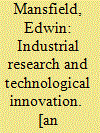

|
|
|
|
|
| Publication |
Lodnon, Longmans, Green, 1968.
|
| Description |
xviii, 235p.
|
|
|
|
|
|
|
|
|
|
|
|
Copies: C:1/I:0,R:0,Q:0
Circulation
| Accession# | Call# | Current Location | Status | Policy | Location |
| 003731 | 338.9/MAN 003731 | Main | On Shelf | General | |
|
|
|
|
| 14 |
ID:
181457


|
|
|
|
|
| Summary/Abstract |
United Nations Sustainable Development Goals (UN-SDGs) such as access to clean energy (SDG-7), responsible energy consumption (SDG-12) and sustainable economic growth revolves around the subject of human development that resonates with (SDG-8), and among others. Based on these highlights, this study examines sustainable development for the panel of selected Sub-Sahara African countries that are largely plagued with huge energy deficit (energy poverty) and setback in technological innovation. This study leverages on panel econometrics strategies to explore the hypothesized relationship between the outlined indicators for the period 2000–2016 in Sub-Saharan African countries. Empirical results show that human development index (HDI), economic expansion, access to clean energy. and technological innovation exhibits long-run equilibrium relationship. Subsequently, the finding revealed that economic expansion, access to energy and technological innovation in the sampled countries spur higher HDI indices. That is, a 1% increase in economic growth increases HDI by 0.040% and 0.017% in the short and long run respectively. Thus, we can infer that enhanced sustainable economic growth leads to higher HDI indices which encompases higher literacy rate, better income level and increase life expectancy in both short and long run. In contrary, access to clean energy in the selected blocs dampens HDI index in the short run but the effect is statistically positive (desirable) in the long run.
|
|
|
|
|
|
|
|
|
|
|
|
|
|
|
|
| 15 |
ID:
042038
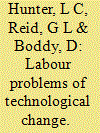

|
|
|
|
|
| Publication |
London, George allen &Unwin Ltd., 1970.
|
| Description |
363p.Hbk
|
| Series |
University of Glasgow social and economic studies
|
| Standard Number |
043310451
|
|
|
|
|
|
|
|
|
|
|
|
Copies: C:1/I:0,R:0,Q:0
Circulation
| Accession# | Call# | Current Location | Status | Policy | Location |
| 004676 | 658.312/HUN 004676 | Main | On Shelf | General | |
|
|
|
|
| 16 |
ID:
014770


|
|
|
|
|
| Publication |
July-Sept 1992.
|
| Description |
321-337
|
|
|
|
|
|
|
|
|
|
|
|
|
|
|
|
| 17 |
ID:
101968


|
|
|
| 18 |
ID:
031107
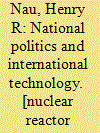

|
|
|
|
|
| Publication |
Baltimore, Johns Hopkings University press, 1974.
|
| Description |
xvi, 287p.
|
| Standard Number |
0801815061
|
|
|
|
|
|
|
|
|
|
|
|
Copies: C:1/I:0,R:0,Q:0
Circulation
| Accession# | Call# | Current Location | Status | Policy | Location |
| 015003 | 333.79240940/NAU 015003 | Main | On Shelf | General | |
|
|
|
|
| 19 |
ID:
180141


|
|
|
|
|
| Summary/Abstract |
This paper aims to analyze the impacts of emission taxes, investments in the energy sector, expenditure on research and development, technological innovation, and tertiary sector development on the Chinese provincial carbon dioxide emission figures between 1995 and 2019. The econometric analysis involved the application of the latest methods which can simultaneously account for cross-sectional dependency, slope heterogeneity, and structural break issues in the data. The overall findings revealed that provincial growth and tertiary sector development were responsible for the aggravation of the carbon dioxide emission trends in China. In contrast, higher energy investments, technological innovation, renewable energy use, expenditure on research and development, and carbon emission taxes are found to abate carbon dioxide emissions and, therefore, facilitate the carbon-abatement agenda of China. Besides, the findings also revealed emission taxes, investment in research and development, technological innovation, and renewable energy use jointly reduce carbon dioxide emissions further. In line with these abovementioned findings, several policy-level recommendations are put forward.
|
|
|
|
|
|
|
|
|
|
|
|
|
|
|
|
| 20 |
ID:
041517
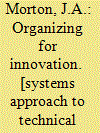

|
|
|
|
|
| Publication |
New York, McGraw Hill Book Company, 1971.
|
| Description |
xviii, 171p.Hbk
|
|
|
|
|
|
|
|
|
|
|
|
Copies: C:1/I:0,R:0,Q:0
Circulation
| Accession# | Call# | Current Location | Status | Policy | Location |
| 006965 | 658.1/MOR 006965 | Main | On Shelf | General | |
|
|
|
|
|
|
|
|
|